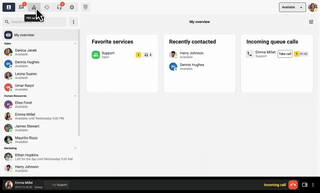Do you have a multilingual support team? Then you know how difficult it can be to find suitable agents, but also how much value it adds to your customers to have a choice of languages. Here’s how to strengthen your business with multilingual customer support.
Multilingual support means that your customer support includes languages other than your chosen corporate language. It’s a great way to include more people by giving them a language choice when they call or contact you online. After selecting a language, they’ll be transferred to an agent who speaks it.
Today’s businesses are international
Business is increasingly international these days. With customers all over the world, this naturally means you need to reach people with different mother tongues. Even if you can’t meet everyone’s wishes(after all, 7151 languages are spoken today), you can adapt to the markets where you have the most customers and future potential.
Customers also have higher expectations today. Since the pandemic, customer service has changed significantly, with customers now demanding a smooth buying journey. But there are many ways to meet these expectations, even if your customer service is remote.
3 reasons to invest in multilingual support
Investing in multilingual support means meeting increased customer demands. Without it, you risk losing customers to other brands that offer support in multiple languages.
1. access to more markets
Multilingual support is beneficial if your business operates internationally, and therefore has customers who speak many different languages. You can then potentially reach more customers.
2. happier customers
As many people are monolingual, this may be the only chance to communicate with them. But even multilingual customers will appreciate being able to choose the language they prefer when they want help.
3. better customer service
Another more direct benefit of multilingual support is that you can resolve more support cases by speaking to customers in the language they understand best. Your support team can work more efficiently and most likely reduce time-to-resolution by eliminating the need for translation or potential miscommunication with the customer.
Read more: Why customer service should measure first-contact resolution
Possible challenges with international support
Find the right staff
Multilingual customer service obviously means that you need to hire multilingual staff. Depending on the size of your business, you may need to find employees who are comfortable communicating in multiple languages, or build specific teams of staff focused on certain languages. Finding staff with the right language skills is challenging but will pay off in the long run.
Content production
The more languages you offer, the more content you need to produce. Ideally, everything produced should be available in all the languages you represent, both internally and externally. This means you need to spend more time on things like translations, quality control, and keeping all support documents and other things up to date.
Managing multiple channels
More languages mean more channels. The best way to manage multiple channels is with an omnichannel contact center. This way, you create a unified communication with your customers, regardless of language and whether they contact you by email or phone.
Lead the customer to the right person
When you offer multilingual support, you can’t route all incoming tickets to just anyone in your support team – they need to reach the right person quickly. But an easy way to solve this is through a communication platform that enables smart routing. Agents can easily see who is available and route calls or messages to the right person.
Summary: Lead a multilingual multilingual support team the right way
If you’ve decided to invest in multilingual customer support, the best way forward is to start by looking at your communication solution.
Gearbox
Choose a switchboard service that enables smart routing, where agents can direct customers to the right department and language based on their previous information, or use digital solutions to route calls to the right person.
You can add a voice response targeting different languages, asking customers to choose the language by saying, for example, “for English, press 2”.
Programmability
A programmable switchboard service is also a powerful solution for designing automated call flows. Your customers get to speak to the person best suited to take the call, as the system recognizes the customer’s number and makes sure to forward the call to the right agent directly. This means that the agent has less admin work and can focus on what is most important: the customer.
Omnichannel
An omnichannel contact center also allows you to manage all communications on one platform. So even if you have people communicating in multiple languages, you get a clear overview.
With omnichannel, customer contact becomes more personal, no matter what language or channel customers choose to contact you in. Unified communication and smoother customer contact across the board.
If you are interested in more information, check out the Telavox omnichannel contact center. And feel free to get in touch if you have any questions!


